White bugs on plants are rarely a good sign. These types of bugs can have a detrimental role in plant health or they can even kill their host plants.
A rare number of white bugs have a beneficial role on plants, mainly by killing invasive species tied to a certain host.
White bugs come in all sizes. From 1 to 10mm, these white bugs seen on plants are often found in North America.
They can be seen on flowers, legumes, bushes, and fruit trees. Many white bugs are also seen on coniferous trees.
White bugs often become white by secreting a type of wax-like texture that has a protective role. This texture often protects these bugs from pesticides and chemical treatments.
Eliminating these bugs is subject to per-species solutions.
Table of Contents
Types of White Bugs on Plants
The following types of white bugs on plants are seen across North America and often around the world.
1. Woolly Alder Aphid
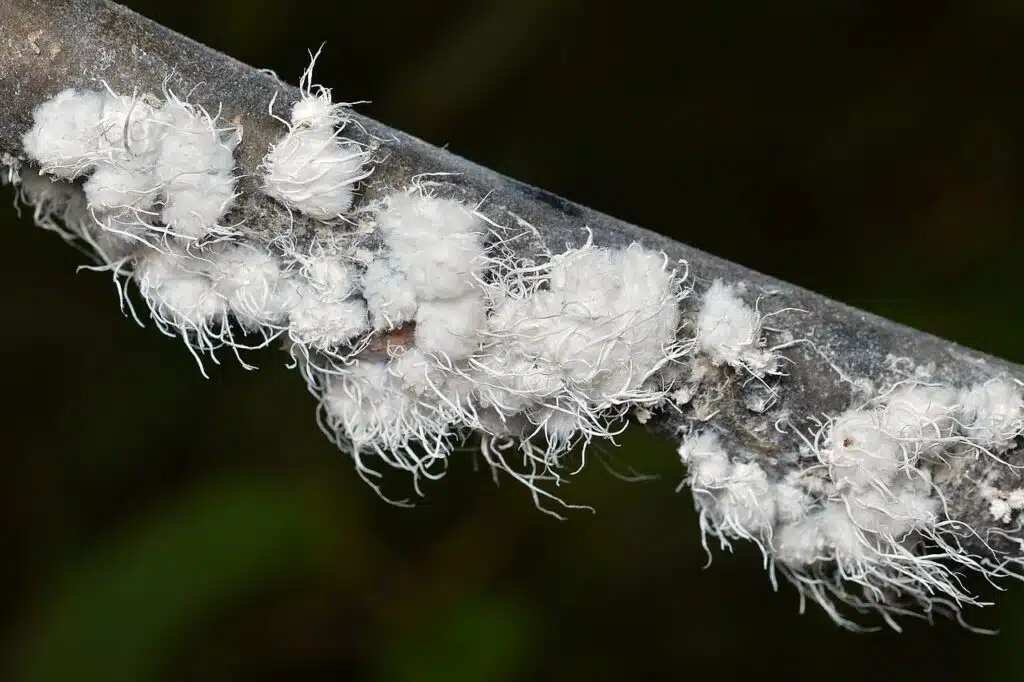
Woolly Alder Aphids (Prociphilus tessellatus) are some of the most common high-number white bugs on trees and plants.
From trees such as silver maple to alder shrubs, these types of aphids can live in high numbers even covering their host.
Woolly aphids are named after a type of waxy texture these bugs produce, routinely known as wool.
This white texture covers the small bugs. Clusters of Wooly Alder Aphids make the bugs form a wool-like surface on leaves and branches.
Wooly Alder Aphids have wings. They can fly to another host or they might decide to fly whenever they are under threat.
Due to their textured appearance, they give the impression of waxy cotton flying through the air.
The habitat of wooly aphids is very specific and they cannot be seen in all types of woodlands.
These aphids move between maple and alder and they require both species.
Aphids of this genus don’t cause significant damage past a few dead leaves on maple and alder.
Management methods aren’t required they need to be kept under observation as they attract honeydew-feeding ants.
2. Hemlock Woolly Adelgid
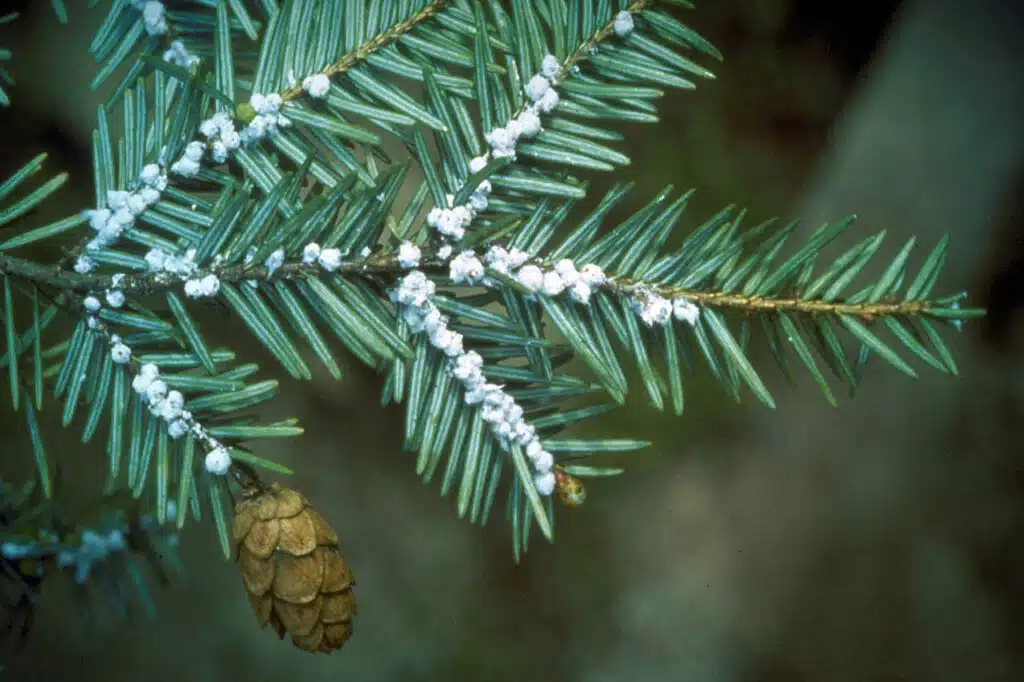
Hemlock Woolly Adelgids (Adelges tsugae) are pests, as opposed to Wooly Alder Aphids.
Native to Japan and East Asia, Hemlock Wooly Adelgids have made their way to Eastern North America and around the range of the Appalachian Mountains.
It’s here that these aphids infest various types of hemlock such as Eastern hemlock.
Coniferous trees in this range are impacted by the small aphid gradually, over a few years.
Covered in a white waxy texture, these aphids settle on the branches of hemlock, first appearing as a white mass rather than looking similar to small bugs.
Eventually, the host hemlock tree dies. It takes no more than 4 years for Hemlock Wooly Adelgids to kill the hosts.
The process by which hemlock hosts die first involves losing needles and buds.
The small aphids feed on the softest needles eventually leading to their decline. Buds that create new branches are also consumed so that the tree has no regeneration chance.
Small mouthparts are used by these aphids to suck out nutrients from hemlock buds and needles.
3. Beech Blight Aphid
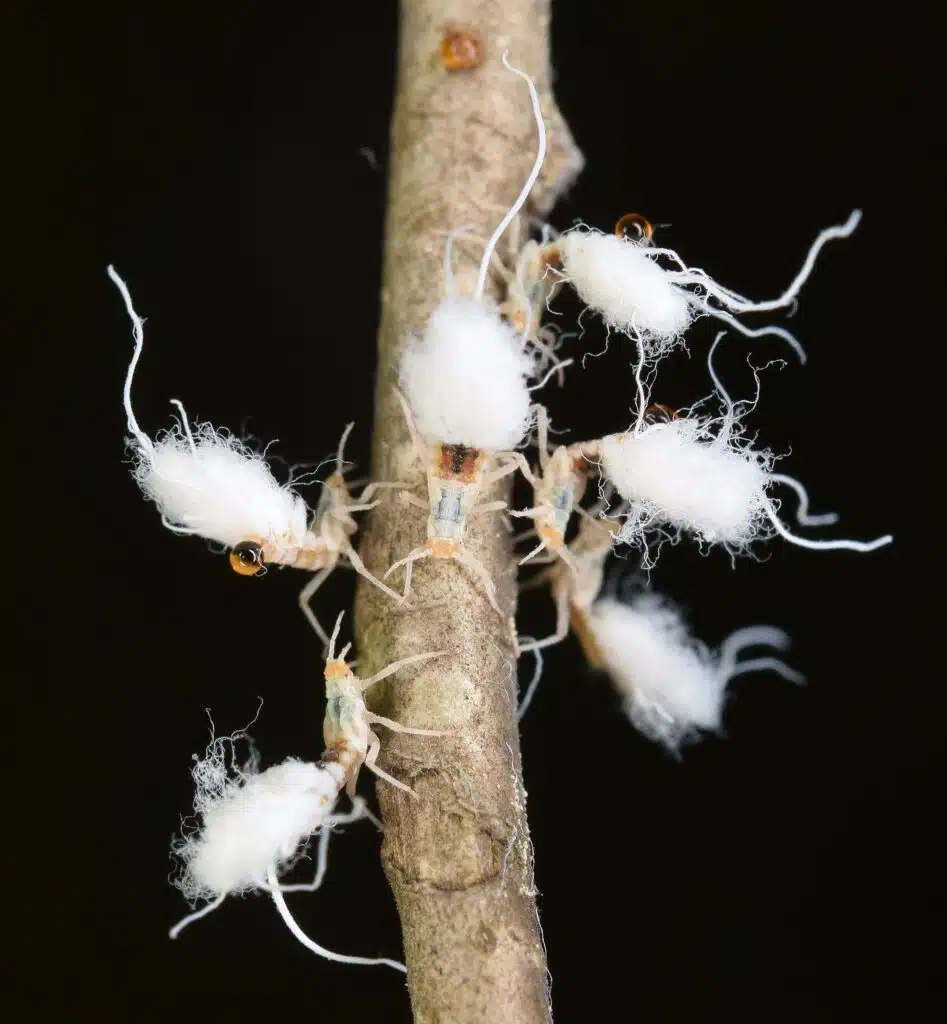
Beech Blight Aphids (Grylloprociphilus imbricator) are found in Eastern and Southeastern US territories.
As Woolly Alder Aphids, Beech Blight Aphids only have 2 known hots.
These small blue aphids covered in a white waxy substance are primarily found on American beech, a species found across the Eastern Coast of the United States.
It also uses bald cypress as a host but to a lesser extent.
Bald cypress may overlap the habitat of the American beech tree, but to a small extent as it’s mostly found in Southeastern US territories.
The bald cypress is known as a swamp tree.
The damages these tree species suffer are typically minor.
Even heavily-infested trees with Beech Blight Aphids only suffer losses such as dying branches, while the tree itself survives heavy infestations.
Decorative trees might be managed by using water sprays to remove the aphids.
Successful preventive measures include spraying insecticide on American beech and bald cypress.
4. Asian Woolly Hackberry Aphid
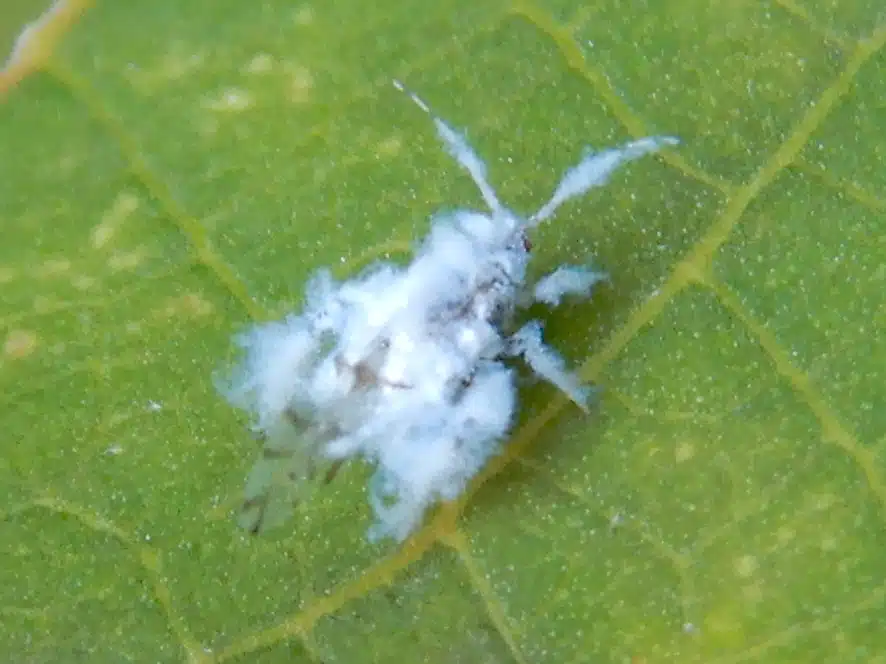
Asian Woolly Hackberry Aphids (Shivaphis celti) are comprised of multiple subspecies with similar characteristics.
All Asian Wooly Hackberry Aphids are tiny, with a maximum adult size of 2mm. They appear white, with blue undertones, as opposed to pure-white wooly aphids.
These types of aphids also secrete a type of waxy substance.
Easily spotted on leaves, Asian Wooly Hackberry Aphids live on the back of hackberry tree leaves.
Multiple types of hackberry around the world are hosts for these aphids.
Korean and Australian hackberry are among the common hosts of various Asian Wooly Hackberry Aphid subspecies.
Damages to the host tree are minimal. These aphids don’t kill hackberry hosts, even when spotted in their thousands.
Pesticides aren’t needed against these aphids.
These aphids can seem the most dangerous in July and August, but they remain a minor pest no specific action is needed against.
5. Pine Bark Adelgid
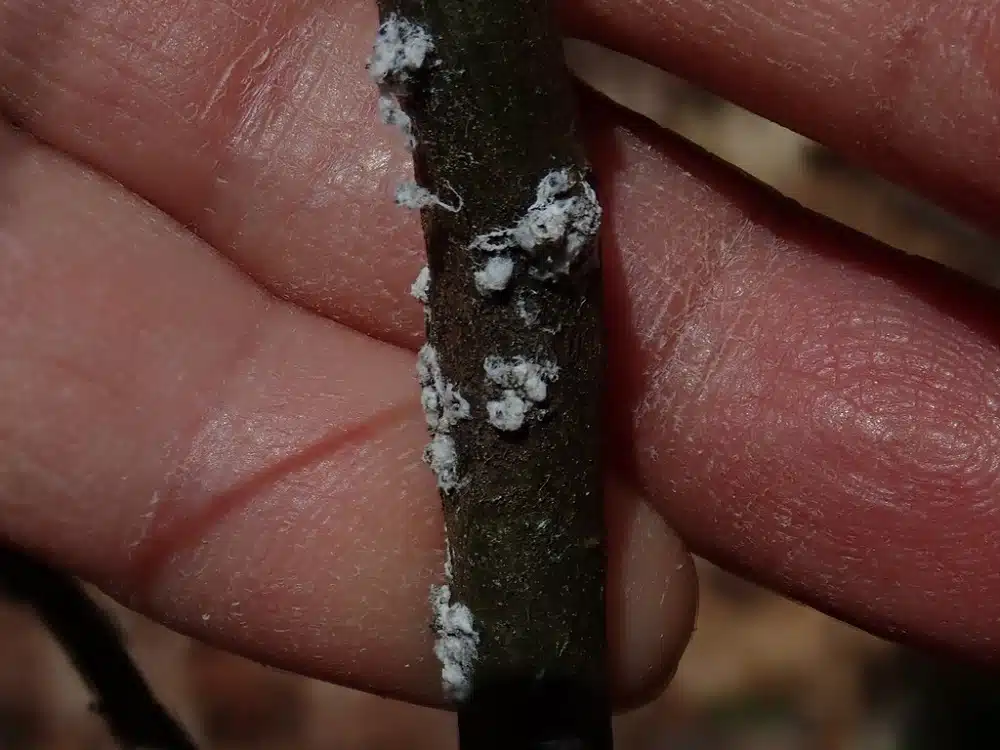
Pine Bark Adelgids (Pineus strobi) are soft-bodied aphids native to Eastern US territories.
This species is an occasional pest of Eastern White Pines.
Pine Bark Adelgids use tree bark to lay eggs. Small yellow eggs are laid in bark crevices and under loose bark.
Once aphids emerge, they grow a white sticky waxy-like texture making them look like snow, as they live in small groups or clumps.
A female Pine Bark Adelgid may lay tens of eggs in a short lifespan.
This species overwinters in a nymph stage, making its appearance in the spring.
Controlling Pine Bark Adelgids might be necessary for certain areas.
Pesticides might be considered to keep these aphids away, as are other non-invasive methods.
Ladybugs are among the predatory species which can eat soft-bodied Pine Bark Aldegids.
6. Woolly Apple Aphid
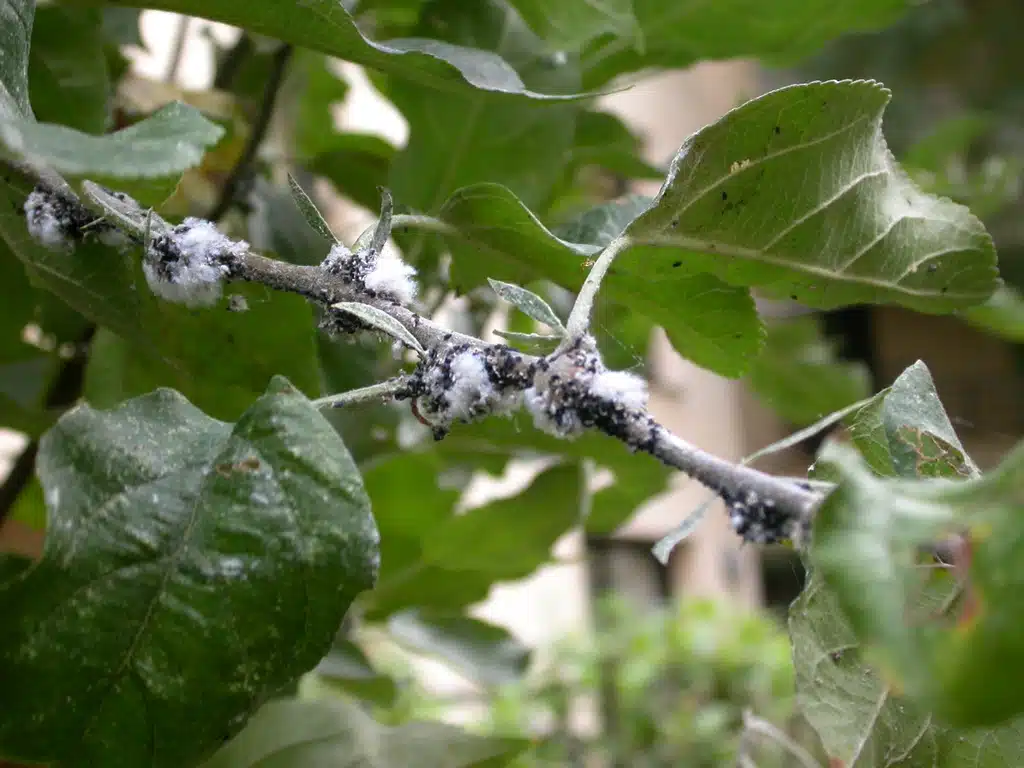
Woolly Apple Aphids (Eriosoma lanigerum) are some of the most common apple tree pests in North America and around the world.
Small differences among members of the species are seen from one continent to another.
For example, North American Woolly Apple Aphids may also impact apple tree roots, as opposed to European aphids of the species which only live above the ground.
Winged and wingless generations of aphids are seen in the spring and in the fall.
These aphids are white and don’t fly when their eggs develop. Winged aphids lay eggs that don’t develop.
These aphids lay eggs and live on tree bark. Overwintering is also possible on the tree itself.
Wooly Apple Aphids are most problematic on young apple trees, which may not survive consecutive season invasions.
Growing to a size of up to 2.6mm, these aphids are known to look for young trees.
While they may also settle on mature apple trees, they don’t impact these hosts to a serious status.
7. Crown Whitefly
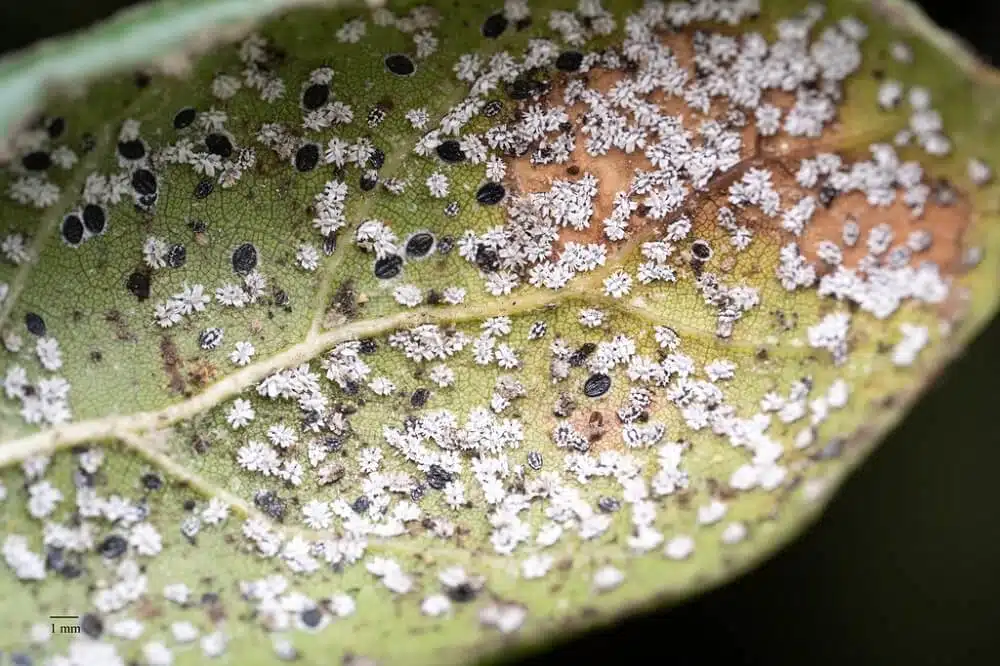
These white aphids (Aleuroplatus coronata) are named after the white waxy border of their pupa.
Crown Whitefly aphids are among the most common aphids in Western parts of North America.
This is a species also tied to 2 host trees. It only eats oak leaves and chinquapin leaves.
Crown Whitefly aphids are seen on these green leaves as white insects.
Impact on the leaves starts to become visible whenever they lose their green color, normally turning yellow and then brown.
While Crown Whitefly aphids don’t kill oak trees, they can make them look unhealthy.
A few measures of control can be applied against them. Pesticides have a reduced success rate.
Horticultural oils are also known to be effective, but not at a full scale due to the waxy coating of the aphid.
Introducing predatory species or multiple horticultural oil applications are among the proven methods to eliminate all aphids from the host trees.
8. Giant Whitefly
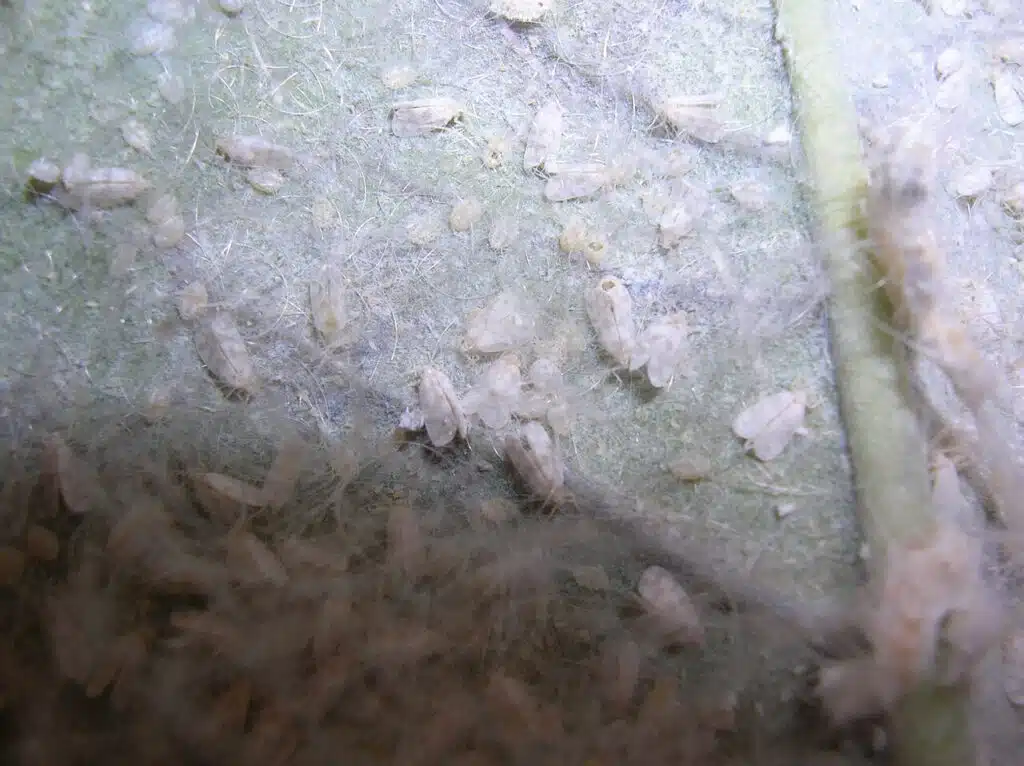
Giant Whitefly aphids (Aleurodicus dugesii) are different from most other white bugs on plants. These aphids cover the leaves of their host plants in a white substance, similar to wax.
This results in stunted plant growth, poor ability to heal affected areas, and eventually, plant death.
The economic losses caused by the species are growing and are still considerable, given its range is limited to California.
Some areas of California are known for diminishing numbers of Giant Whitefly aphids, mainly due to a higher presence of predators such as parasitic wasps.
First seen around the San Diego region, the Giant Whitefly now causes economic losses across multiple areas of the state.
These aphids are further known to impact a larger number of species.
Plants such as begonias and hibiscus are known, hosts. Greenhouse impacts include banana cultures.
These species have wings and prefer to settle on the underside of leaves, which might make them difficult to spot.
9. Mealybugs
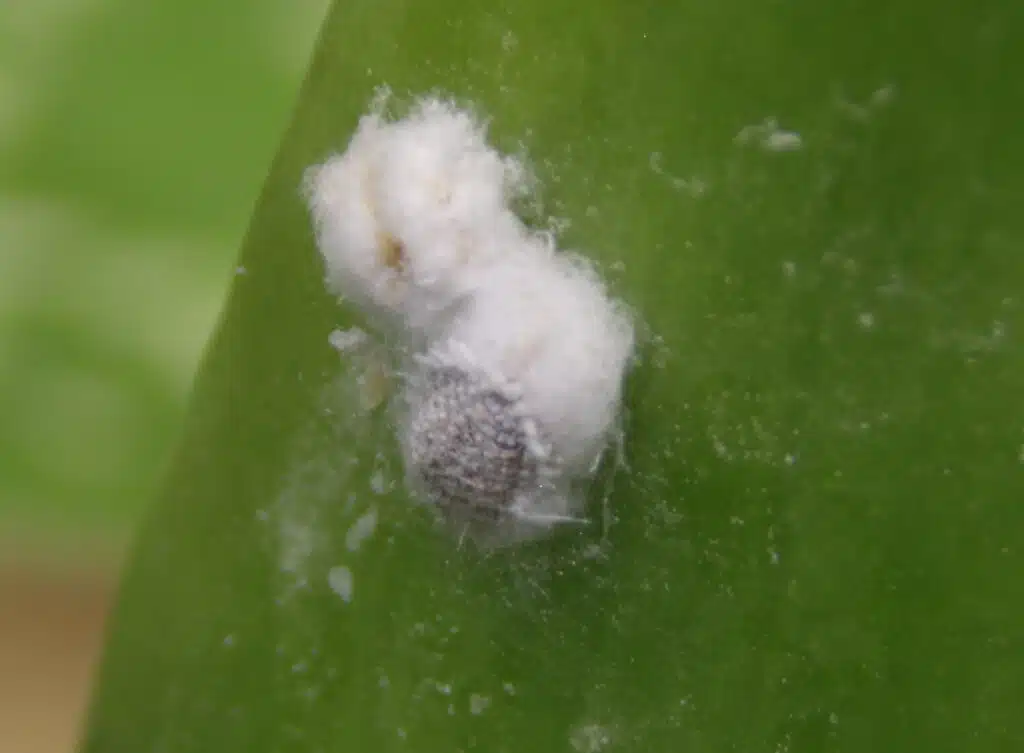
Mealybugs (family Pseudococcidae) have widespread worldwide distribution.
These types of bugs are also tiny and they might appear similar to aphids, especially in the case of males.
A white texture covers their body, which further makes the species resemble aphids.
There are more female mealybugs than males, especially on plants. Females may lay unfertilized eggs once per year.
Mealybugs have a mainly detrimental role on plants, feeding on plant sap in various species.
Grape vines and coffee trees are among the most impacted hosts of mealybugs.
However, this species may also have a positive role, albeit to a lesser extent. They can feed on various weeds and invasive species of cacti.
Mealybugs often have a small number of natural predators as they’re protected by honeydew-feeding ants.
Both chemical and natural sprays can be used against mealybugs.
The type of management solution is chosen based on the type of hosts.
Natural oils are used on fruit-bearing hosts. However, the removal of mealybugs is necessary before any type of management measure or preventive measure.
10. Cottony Cushion Scale
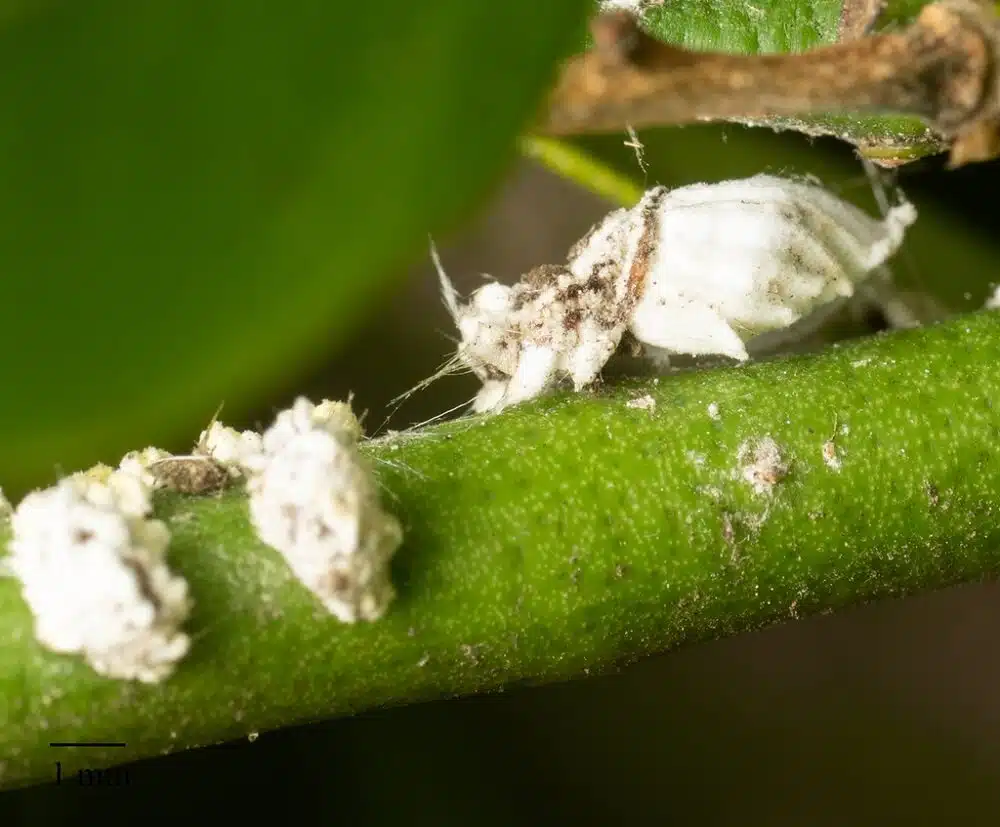
Cottony Cushion Scales (Icerya purchase) have an introduced status in North America.
They are believed to be of Australian origin where they fed on acacia.
In the United States, the white Cottony Cushion Scale is a primordial pest of citruses.
It affects various types of citruses until fruit production starts to suffer.
Florida is among the states where this species is prevalent.
This species is also seen in California as a sole member of the Icerya family in the state.
Various management methods have been tried and tested in North America against the Cottony Cushion Scale and this includes local quarantine.
You can identify Cottony Cushion Scales by their waxy white bodies.
This species looks similar to aphids as nymphs as the white waxy texture starts to grow in adulthood.
Cottony Cushion Scales are seen as one of the main prey bugs of ladybugs.
11. Beech Scale
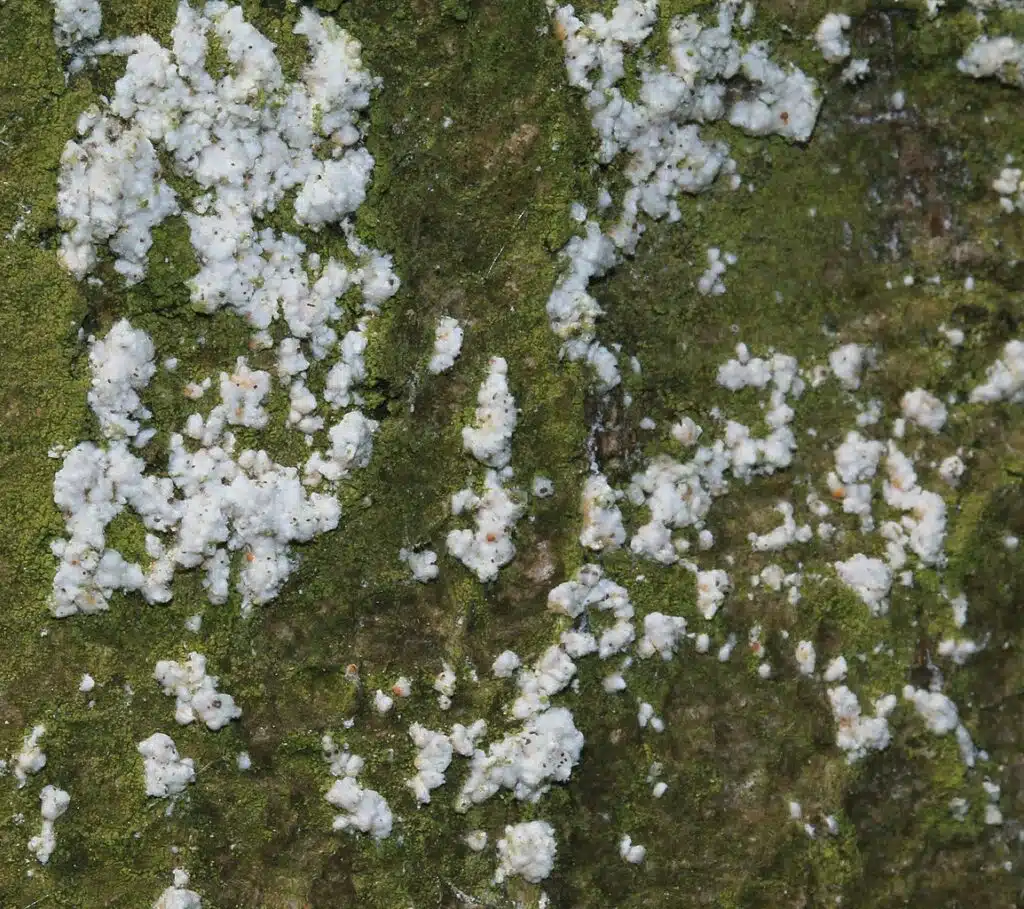
Beech Scale (Cryptococcus fagisuga) insects are among the most important beech tree pests.
They have a pest status both in North America and Europe. Canadian beech trees can also suffer from Beech Scale invasions.
This is a type of cream-color nymph that grows white waxy substances across its body as an adult.
Beech scale insects are formed of females who lay fertilized eggs. There are no male Beech scales.
These insects grow on the bark of the host tree and help spread a potentially deadly disease known as the beech bark tree disease.
A disease like this dries essential areas of the trees or kills them completely.
Beech scale insects need extensive management techniques as ladybug predators only partially eliminate them from a given area.
Unlike other white bugs, these bugs are only selecting old beech trees and not young ones which can produce a substance that deters them.
Extensive winters seem to be among the few natural processes that kill beech scales.
12. Euonymus Scale
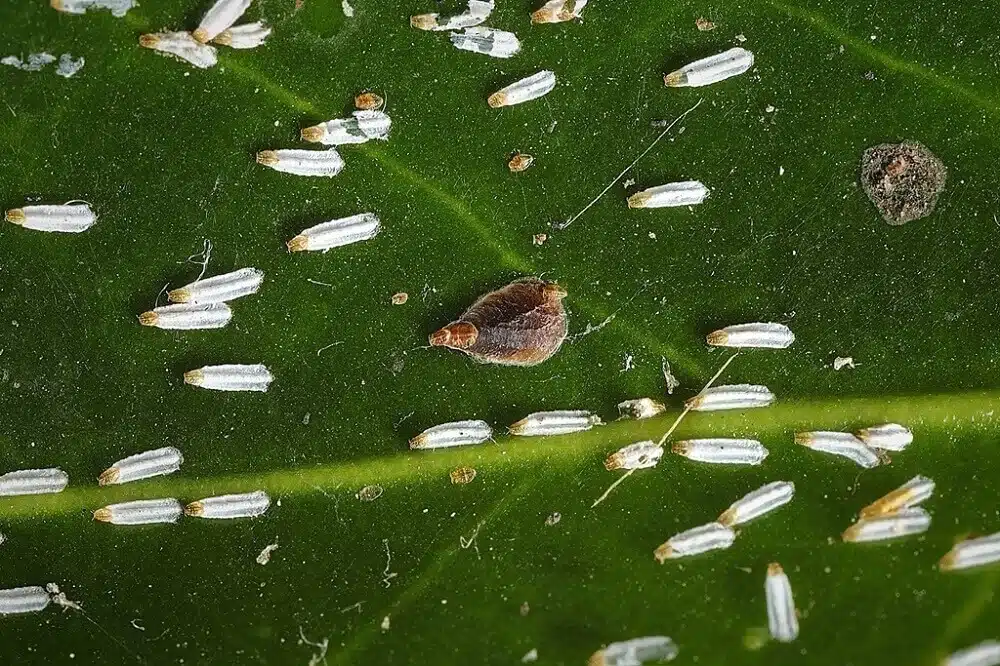
Euonymus (Unaspis euonymi) is one of the most infested hosts of the Euonymus scale. These white bugs also impact decorative plants such as lilac and hibiscus.
These white bugs feed on the lower-level leaves at first. Considerable invasions cover the host plant in white color.
Not all types of hosts of this type are chosen by these scales. They prefer hosts in poor health.
This is why hosts that are properly fertilized and which are healthy are less likely to attract the bugs.
Euonymus Scale insects may also be manually removed when spotted early. Horticultural sprays may also be used in wider number scales.
Natural enemies such as ladybugs and wasps may still eliminate a low number of Euonymus Scales before action is taken against them.
13. Cactus Scattered Cochineal
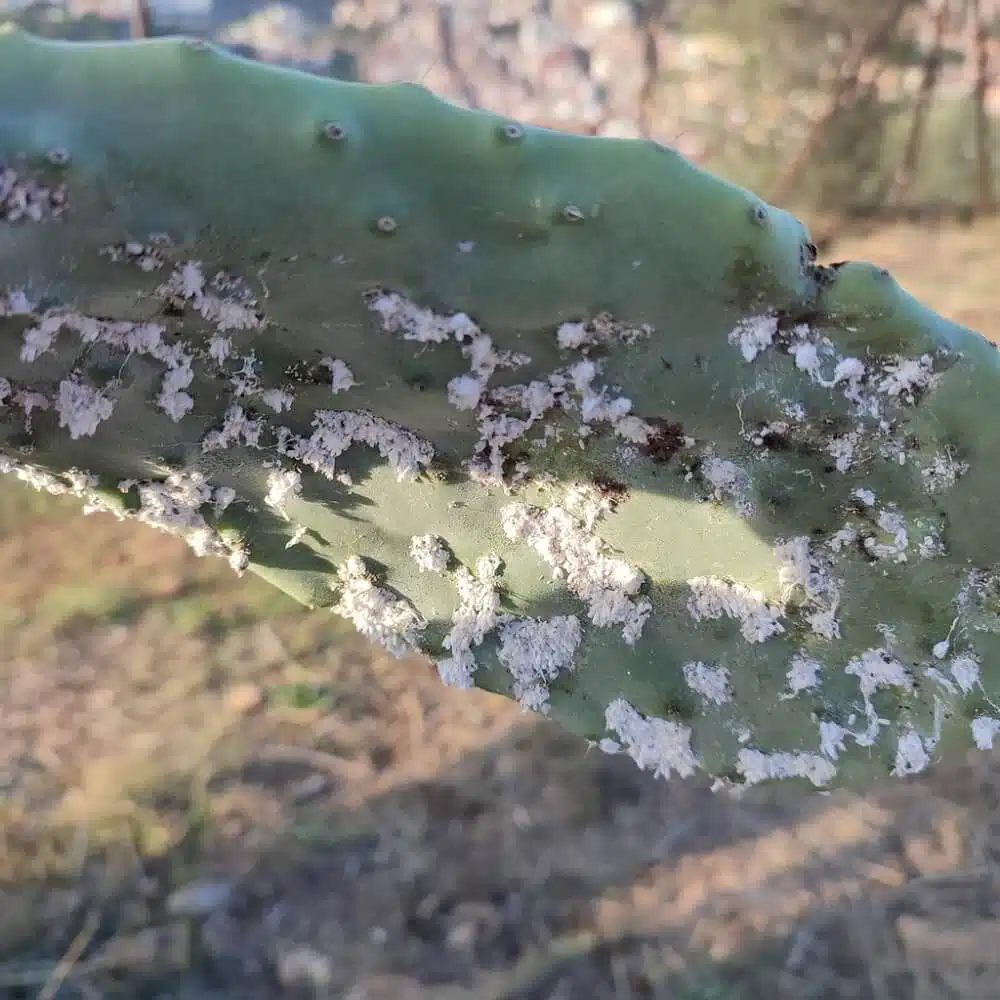
This type of white bug (Dactylopius opuntiae) is seen differently, depending on its region.
It has a pest status in many regions of the world such as Southern Europe where its host, prickly pear, is seen as food.
This type of cacti food already has proven benefits.
It can be used in diets aimed at diabetics or for those looking to lose weight. As a result, the presence of this type of white bug on prickly pear is seen as a problem.
Cactus Scattered Cochineal had different biological control purposes in the past.
This was a species that was used to eliminate cacti in certain warm regions of the world.
Today, the same species is controlled to avoid impacts on edible cacti crops.
14. Pine Needle Scale
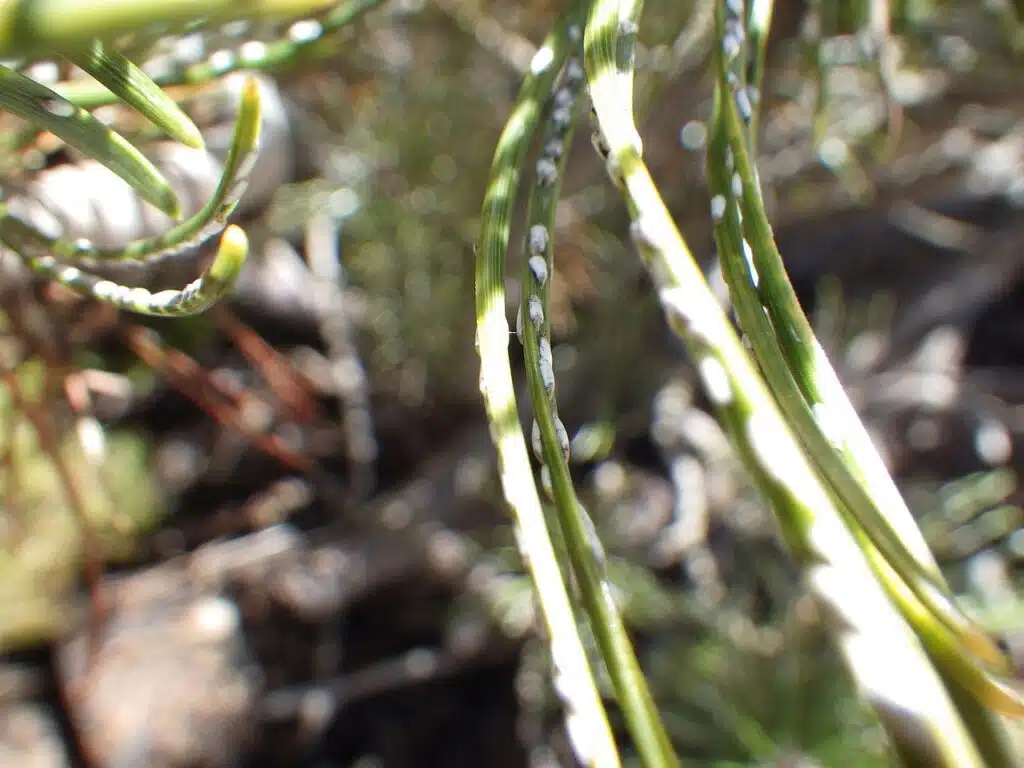
Pine Needle Scale insects (Chionaspis pinifoliae) are native to small regions of North America where various species of pine trees are found.
This type of scale insect affects many Christmas trees as white initially looks like a white mass.
It feeds on soft pine needles, sucking out their juices. These needles then turn yellow or brown before dying.
The entire impact of the species can be considerable, but only in the case of serious invasions.
Scales of this family settle on a given pine tree. They then grow a white waxy texture on their bodies.
They begin sucking out vital juices from pine needles afterward, as adults.
You can spot these scale insects early on ornamental pine trees around the house.
They tend to become active either in late March or at the beginning of April, after overwintering.
Parasitoid wasps are among the most common predators of the species seen with the multiple broods of these scale insects.
15. Crape Myrtle Bark Scale
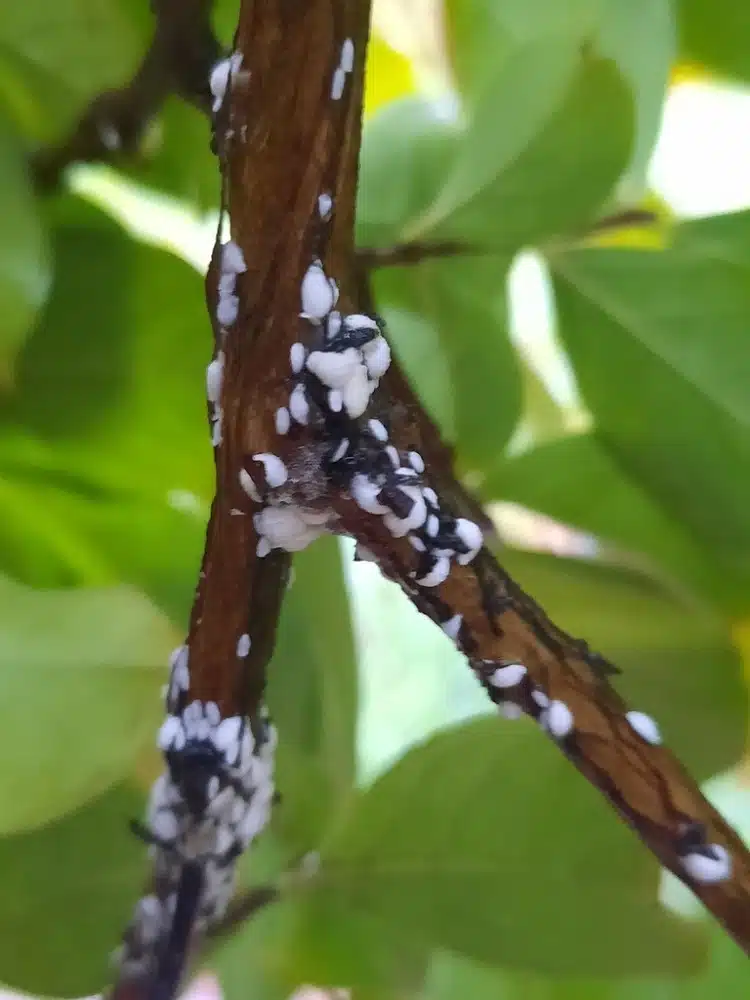
This small white bug (Eriococcus lagerstroemiae) is the only scale insect that feeds and lives on crapemyrtle in North America.
Bugs of this family feed on this resilient host which is a top choice in gardening due to its low maintenance profile.
Crape Myrtle Bark Scales are found in Southern states, especially across Texas and Oklahoma.
They feed on the bark of crapemyrtle and are identified by their elongated white bodies. They are covered in a white wax-like material as these bugs are initially pink, as nymphs.
It’s also the nymphs of the species that attract a very high number of ants through honeydew.
Managing these bugs involves taking early action. While they rarely kill the host, these small white bugs may still cause visible unpleasant damage to their ornamental hosts.
Natural predators are among the most efficient control methods against Crape Myrtle Bark Scales.
Beetles such as the twice-stabbed lady beetle are efficient predators of the tiny white bugs.
16. Indian Wax Scale
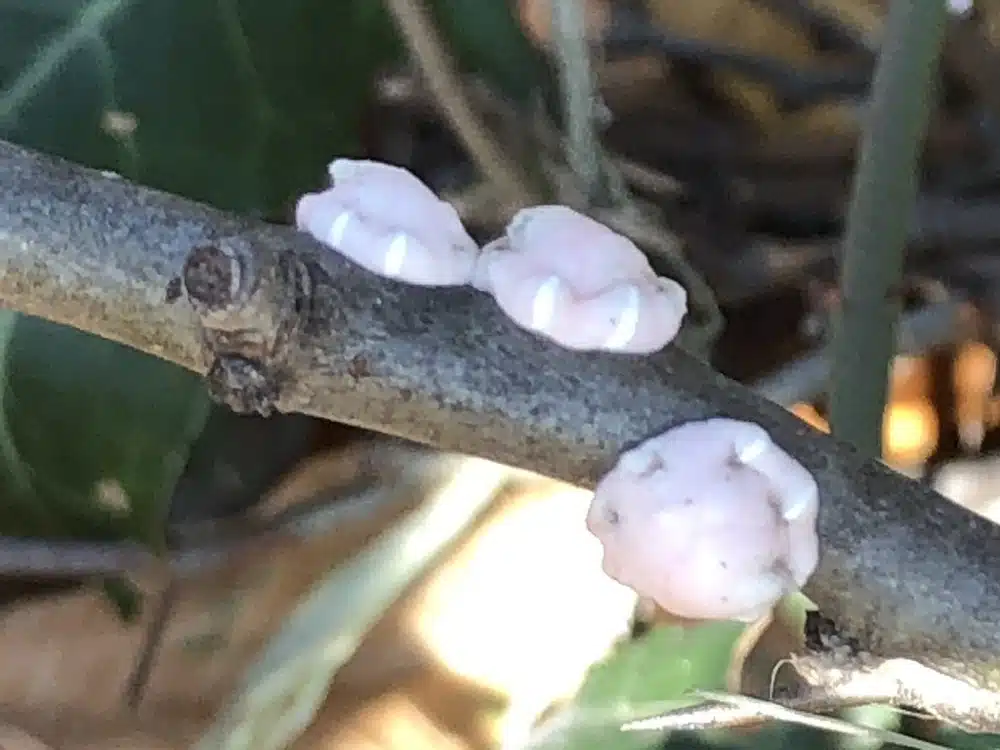
Various types of evergreen plants and trees are the hosts of the Indian Wax Scale (Ceroplastes ceriferus).
This is a type of scale insect seen on Chinese elm and citruses.
It can invade both fruit-bearing plants and decorative plants such as jasmine.
Other rare types of hosts of the deciduous (falling leaf) genus include various quinces.
Indian Wax Scale insects are fully covered in a waxy-texture buildup.
This type of waxy material often protects these scale insects from pesticides and makes chemical-based controls not fully successful.
Summertime is the period when these scale insects are seen in the highest numbers.
Indian Wax Scale insects are known for very high reproduction rates. A single female insect may lag as many as 2.000 eggs per season.
Emerging nymphs and adults then begin feeding on the leaves of various host plants.
17. Spider Mites
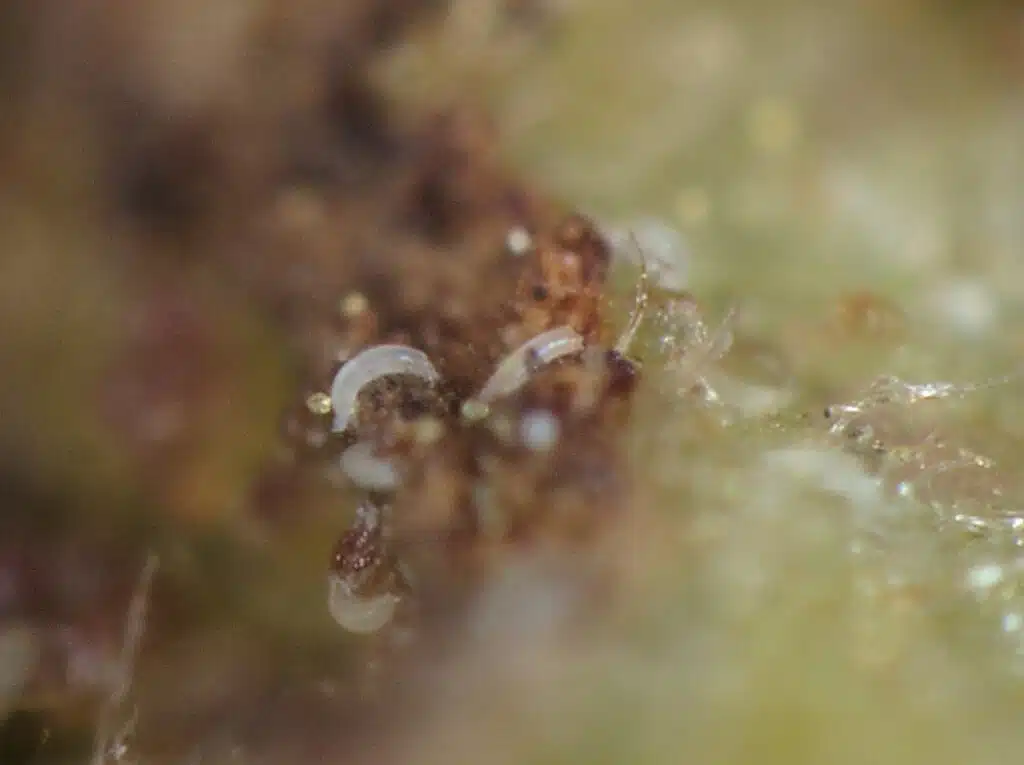
Small spider mites grow white hairs and are seen as major pests across multiple types of important crops.
Potatoes and corn are among the most important crops impacted by these tiny white bugs (family Tetranychidae).
Spider mites are among the smallest types of bugs seen on crops.
These mites grow to a size of 1mm and they sometimes come in different colors, even in the same location.
The most important type of damage comes from the silk web these bugs produce. A type of arachnid, Spider mites build silk webbing on the leaves they feed on.
The positioning of spider mites makes them difficult to truly eradicate by spraying chemicals.
They only live on the underside of leaves.
Encouraging natural predators such as six-spotted thrips is recommended.
18. Mealybug Destroyer Larvae
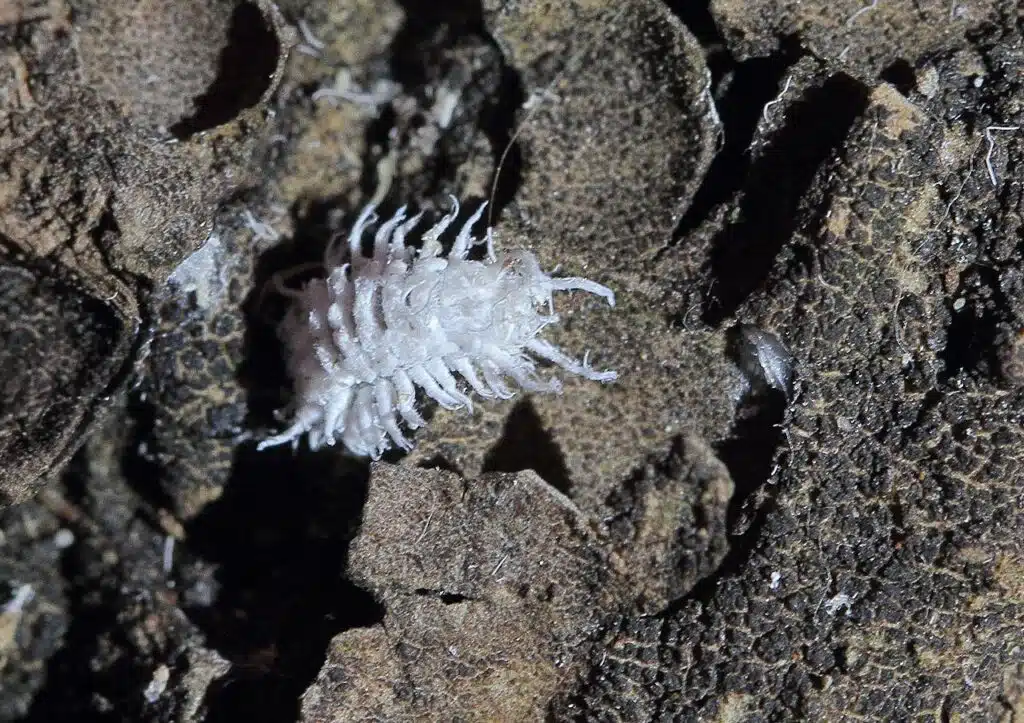
This species (Cryptolaemus montrouzieri) gets its name after the mealybugs it consumes. While adult Mealybug Destroyers are black and brown, its larvae are white.
The larvae of the species have a white waxy texture but it shares their dietary preferences with the adult.
Both adults and the larvae of Mealybug Destroyers feed on mealybugs, giving them a positive role in the ecosystem.
The larvae may be a common sight across citrus groves in some US states.
The larvae might evat eat more than the adults as they can eat hundreds of mealybugs until reaching an adult stage.
Dispersed by air, these types of larvae are dependent on viable host plants.
A way by which adult Mealybug Destroyers identify viable plants is by finding those with honeydew traces.
19. Sri Lanka Weevil
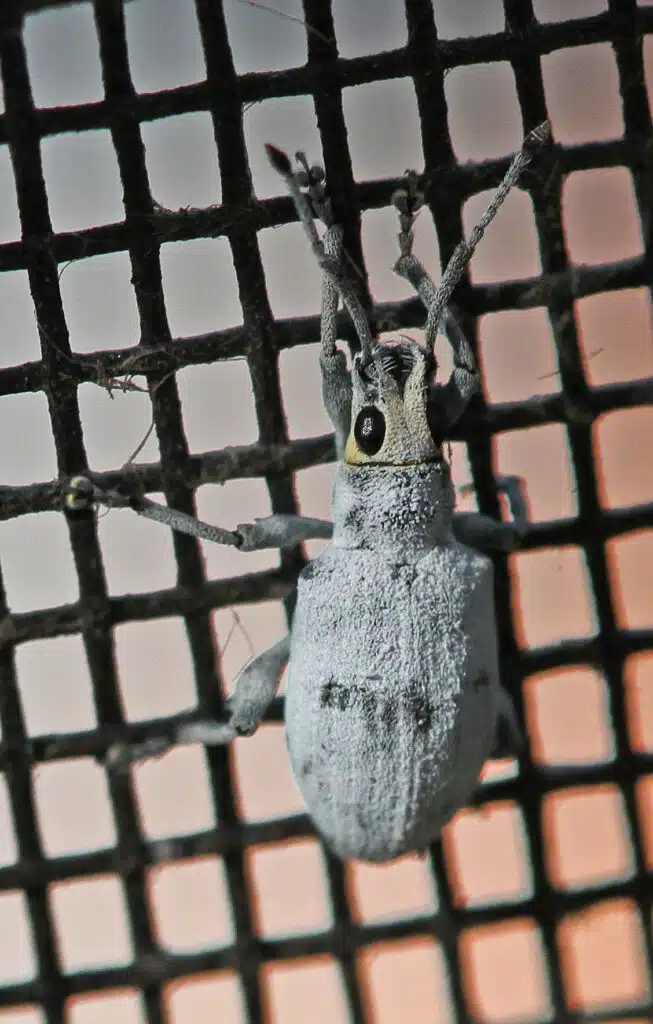
Sri Lanka Weevils (Myllocerus undecimpustulatus) are a relatively new species in the United States. A growing presence of the species is noted in Florida.
These are some of the largest types of white bugs on North American plants as the adult may reach a maximum size of 8.5mm.
Smaller adults still measure at least 6.5mm.
A wide range of hosts is specific to this pest. This includes plants, flowers, legumes, and fruit-bearing trees and shrubs.
Citruses used to be first linked with this weevil. However, its diet now includes hundreds of species in Florida alone.
Sri Lanka Weevils cause different levels of damage with the capacity to completely kill host plants.
The larvae feed on roots while adults feed on leaves. Complete defoliation is not uncommon when it comes to the species.
20. Fifteen-spotted Lady Beetle
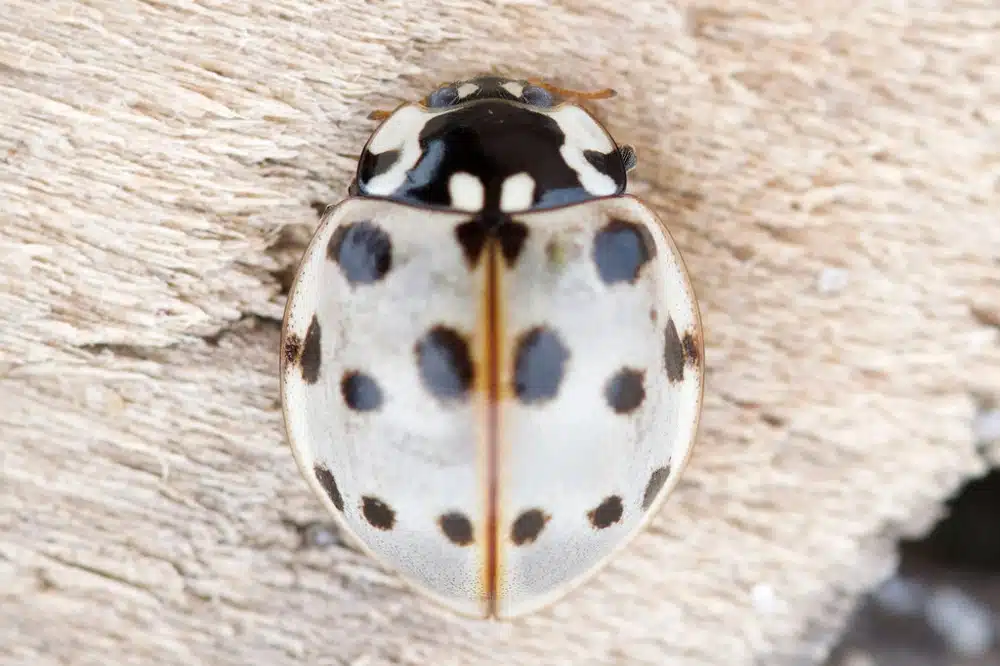
Fifteen-spotted Lady Beetles (Anatis labiculata) are among the rare white lady beetles. A white morph with black spots is seen on the species.
Seen in Eastern territories of the US and Canada, the species is one of the larger white bugs on plants.
It grows up to a size of 9.5mm and it can be seen as a beneficial species to the ecosystem.
White Fifteen-Spotted Lady beetles are among the most common species known to feed on aphids in Texas.
Its diet also includes smaller bugs such as scale insects.
Beaches are known to be places where the species is seen in high numbers. The bug is also seen in woodlands.
Most beetles of this family are seen on trees where they look for various types of tree aphids.
Seen until Mid-July, this species eventually starts to darken. By the last days of its life, the bug has a dark brown color.
How to Get Rid of White Bugs on Plants
Most types of white bugs on plants need to be eliminated. Failing to take action might mean these bugs multiply to the point of killing their host plant.
Pesticides are often seen as the main solution against bugs in parks, gardens, and crops.
Most types of white bugs cannot be eliminated by spraying pesticides as they hide under leaves or may even fly away.
Here are some of the most common methods of eliminating or keeping white bugs away from plants.
Manual removal
Early detection is best for manual removal since bugs multiply in high numbers which would make them difficult to remove by hand.
April is one of the earliest months white bugs are seen on plants and trees in North America. It’s one of the best times to assess plants by looking at the underside of leaves.
Taking early action with manual removal might also be one of the best periods for spraying natural sprays or horticultural oil for multi-brood white bugs.
Spraying the plants with water
Pressure washers might be a handy solution to eliminate white bugs on certain types of hosts. A small tree such as an apple tree might be an example host where a pressure washer is useful but not harmful.
Legumes and other types of delicate hosts might still benefit from watering down using a water hose.
Make sure to take your time as many of these white bugs live on the underside of leaves, away from the attention of common predators.
Horticultural oil
Horticultural oils are hydro-carbons with natural elements, as opposed to the chemicals in pesticides.
Often considered a safer alternative to pesticides, horticultural oils have a lesser impact on the soil and humans themselves.
Depending on the type of plant bug, horticultural oils might act as a preventive measure that keeps plants bug-free.
Horticultural oils can be used both in gardens and on crops.
Pesticides
Pesticides are among the most potent anti-bug solutions available today. Typically applied by professionals and a solution on crops, they eliminate many types of white bugs.
Not all bugs can be eliminated by pesticides. Species with higher white wax-like secretions have been shown to repel pesticides.
Winged bugs might also fly away so that a smaller number of insects are killed by pesticides.
Predatory species
Ladybugs and parasitoid wasps are among the predators of selected white bugs. These types of predators limit the spread of these bugs in a given area.
Only species without many natural predators in a geographic area are completely immune to predators.
This typically applies to imported species that don’t get many local predators in their new habitat.
Frequent watering
Studies show plants with good vigor and in good health are less likely to attract white bugs.
Frequent watering is one of the careful steps to consider when it comes to maintaining good plant health.
Some white bugs specifically seek out plants in a poor state to settle in so it’s worth taking care of each plant is water according to its need.
It’s also as important to prevent plant overwatering, as this might also attract certain bugs and insects.
Using proper fertilization for healthy plants
Proper fertilization has also been proven to be an efficient method against white bugs.
Fertilized and well-drained soil is ideal for most plants. This keeps them healthy.
Since many white bug larvae seek out the roots of plants, it’s also worth improving soil quality on crops or in gardens.
Taking care of young trees
White bugs can further be categorized by the types of host plants they infest and by their age.
Some bugs prefer young trees while others prefer old trees.
Woolly Apple Aphids are shown to favor young apple trees. Many trees are vulnerable in their early growth stages and need extra maintenance to survive bug infestations.
Taking care of old trees
Other white bugs prefer old trees. Beech scales are among the species specifically seeking out old beech hosts.
Old trees might need to be protected with preventive measures such as good watering habits, soil fertilization, and horticultural oils to survive bug invasions.
When not to remove bugs on plants
Not all arboreal white bugs are detrimental. Some play a positive role in the ecosystem and shouldn’t be killed.
Fifteen-spotted lady beetles are among the white bugs that feed on aphids.
This species may be found in woodlands, gardens, or crops next to woodlands.
White beetles of this genus control aphid populations up to mid-July.
Killing these white bugs considerably reduces the natural predators of aphids in a given area.
This species can be among the few predators of aphids that feed on both hardwood and coniferous trees.